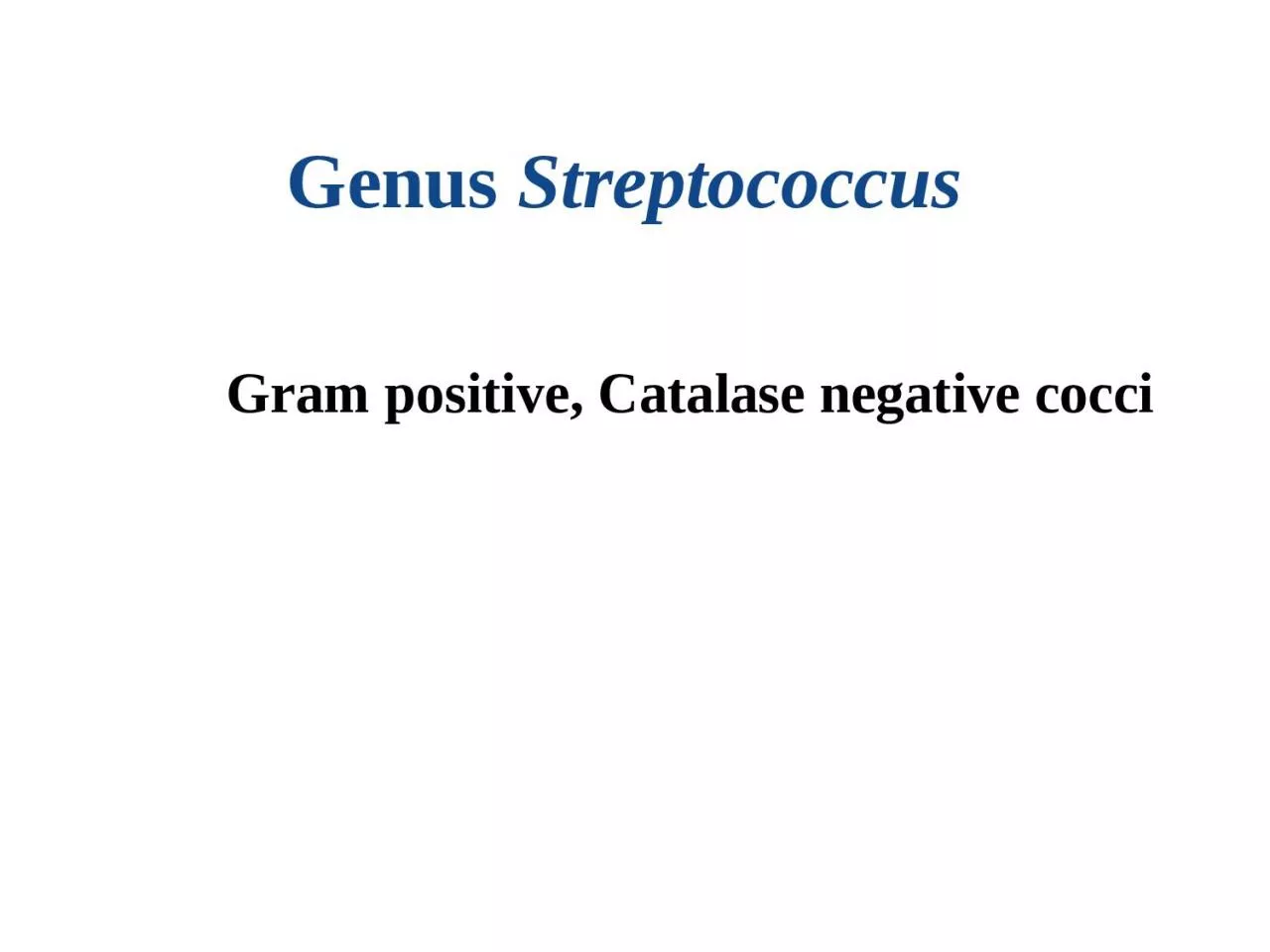

objectives Study systemic bacteriology Describe Genus Streptococcus its types pathogenesis and lab diagnosis When grown on sheep blood agar streptococci display one of three types ID: 914861
Download Presentation The PPT/PDF document "Genus Streptococcus Gram positive, Cata..." is the property of its rightful owner. Permission is granted to download and print the materials on this web site for personal, non-commercial use only, and to display it on your personal computer provided you do not modify the materials and that you retain all copyright notices contained in the materials. By downloading content from our website, you accept the terms of this agreement.
Slide1
Genus Streptococcus
Gram positive, Catalase negative cocci
Slide2objectives* Study systemic bacteriology* Describe Genus Streptococcus, its types, pathogenesis, and lab diagnosis.
Slide3Slide4Slide5Slide6When grown on sheep blood agar, streptococci display one
of three types of hemolysis of the red blood cells in the agar.
Alpha hemolysis-
-The red blood cells in the media are partially digested producing a greening of the agar.
Beta hemolysis-
-The red blood cells in the media are completely digested producing a clearing of the agar.
Gamma hemolysis-
-No change is noted in the agar. The red blood cells are not lysed.
Expected Hemolysis:
Streptococcus
pyogenes
always beta
hemolylic
Streptococcus
agalactiae
usually beta hemolytic
Streptococcus
pneumoniae
and
Viridans
streptococci
are always alpha
hemolylic
Enterococcus
faecalis
gamma hemolytic
Slide7Hemolysis patterns on blood agar
7
Slide8S.pyogenes on blood agar (beta hemolysis)
(Beta hemolysis) clear zone around colonies
Slide9Alpha hemolysis (green discoloration)
Slide10GENERAL CHARACTERISTIC:
* G+ve cocci , arrange in chains or pairs.* Some strains are capsulated
* Majority are facultative anaerobic, few are obligatory anaerobic.
*
Catalase –ve
* Non motile.
* Non spore forming
* Fastidious microorganism
Slide11S.pyogenes (Group A β- hemolytic,GABH):
M-protein80 serotypes
Reservoir
Human throat
and
skin(N.F.)
Transmission
Spread by respiratory droplets or direct contact
Slide12DISEASES S.pyogenes
Slide13Acute Tonsillitis
Slide14Laboratory Diagnostic steps
Slide15Lab dx.of strept. Pyogenes
Specimens: sputum, throat swab, nasopharyngeal swab, blood, CSF…etc.Gram stain: G+ve cocci,
arrange in chains.
Culture:
on
blood agar
pinpointed, Grayish white, translucent, matte or glossy colonies with large zone of β- hemolysis.
Bacitracin disc
(0.04 U)
sensitive
causes zone of growth inhibition.
Serology
: Lancefield grouping, M-protein
serotyping
and
ASO test
(
Antistreptolysin
-O test).
Slide16ASO test:* Measure Ab against Streptolysin O*ASO test uses in post streptococcal infection complication. This test used to determine significance streptococcal infection
by measuring the ASOT:* ASOT (Ab Titer): Normal < 200 < significance result
Slide17Slide18S.pyogenes on blood agar (beta hemolysis)
Slide19S.agalactia
(Group B β- hemolytic):
Slide20Biochemical IdentificationChristie-Atkins, Munch-Petersen (CAMP) testDetects the production of enhanced hemolysis that occurs when b
-lysin and the hemolysins of Group B streptococci come in contact
Group B streptococci showing the classical “arrow-shaped hemolysis near the staphylococcus streak
Slide21Identification
of group D Streptococci:
Lancefield Group D streptococci are divided into two groups: (1) Enterococci, and (2)
nonenterococci
.
Enterococcus
faecalis
and
Enterococcus
faecium
are the species of
Enterococcus
.
Strep.
bovis
and
Strep.
equinus
are species of "Group-D streptococci, not Enterococci".
Slide22Enterococcus
(E.faecalis,
E.faecium
)
Slide23Bile-
Esculin
Hydrolysis Test:
The purpose of this test is to determine the ability of an organism to hydrolyze the glycoside
esculin
to
esculatin
and glucose in the presence of bile (10 - 40%). This test aids in the differentiation of group D streptococci from other "not group D streptococci".
Procedure:
1. Inoculate the organism to be tested into the bile
esculin
medium. Incubate at 37
o
C for 24 hours (stab into
medium,then
streak on slant).
Positive Test: Presence of a black to dark brown color on the slant -(
Enterococcus
faecalis
) Negative Test: No blackening of the medium - (
Streptococcus
agalactiae
or Streptococcus
pyogenes
)
Slide24Slide25Viridans Streptococcus
Slide26Alpha hemolysis (green discoloration)
Slide27S.pneumoniae
(Pneumococci,
Diplococcus
pneumoniae
)
Capsular polysaccharide
Gram +VE diplococcus
Slide28Diseases
Slide29CHARACTER
PNEUMOCOCCI
VIRIDANS STREPTOCOCCI
Morphology
Ovoid or
lanceolate
diplococci
Rounded cocci in short or long chains.
Capsule
Present
Absent
Optochin sensitivity
+
ve
-
ve
Bile solubility
+
ve
-
ve
Capsular swelling test (
Quelling reaction
)
+
ve
-
ve
Virulence in mice
+
ve
-
ve
Slide30Lab dx
.
Slide31Slide32Optochin disc for
S.pneumococci
Slide33Slide34Question? Name this test
Slide35THANKS